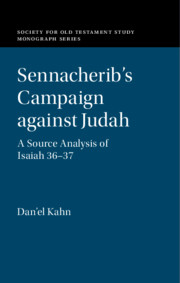Book contents
- Sennacherib’s Campaign against Judah
- Society for Old Testament Study Monograph Series
- Sennacherib’s Campaign against Judah
- Copyright page
- Dedication
- Contents
- Abbreviations
- Preface
- Acknowledgments
- Introduction
- 1 The Problems in Isaiah 36–37
- 2 Previous Solutions
- 3 A New Historical-Critical Solution
- 4 Source BI
- 5 The Political Events in the Eighth Century BCE and the Results of the 701 BCE Campaign
- 6 Source BII
- 7 The Historical Background of Source BII (683–671 BCE)
- 8 The BIII Strand
- 9 The Babylonian Period
- 10 The Question of the Priority of Isaiah 36–37 vs. 2 Kings 18:13–19:37
- 11 Isaiah 36–37 and Their Location in the Literary Unit Isaiah 36–39
- 12 The Present Location of Isaiah 36–39 in the Book of Isaiah and the Formation of the Book
- 13 2 Chronicles 32 and Its Relation to Isaiah 36–37
- 14 Summary and Conclusions
- Appendix – Biblical Texts
- Bibliography
- Index to Biblical Passages Cited
- Index of Geographic Names and Peoples
- Index of Names
- References
Bibliography
Published online by Cambridge University Press: 29 September 2020
- Sennacherib’s Campaign against Judah
- Society for Old Testament Study Monograph Series
- Sennacherib’s Campaign against Judah
- Copyright page
- Dedication
- Contents
- Abbreviations
- Preface
- Acknowledgments
- Introduction
- 1 The Problems in Isaiah 36–37
- 2 Previous Solutions
- 3 A New Historical-Critical Solution
- 4 Source BI
- 5 The Political Events in the Eighth Century BCE and the Results of the 701 BCE Campaign
- 6 Source BII
- 7 The Historical Background of Source BII (683–671 BCE)
- 8 The BIII Strand
- 9 The Babylonian Period
- 10 The Question of the Priority of Isaiah 36–37 vs. 2 Kings 18:13–19:37
- 11 Isaiah 36–37 and Their Location in the Literary Unit Isaiah 36–39
- 12 The Present Location of Isaiah 36–39 in the Book of Isaiah and the Formation of the Book
- 13 2 Chronicles 32 and Its Relation to Isaiah 36–37
- 14 Summary and Conclusions
- Appendix – Biblical Texts
- Bibliography
- Index to Biblical Passages Cited
- Index of Geographic Names and Peoples
- Index of Names
- References
Summary

- Type
- Chapter
- Information
- Sennacherib's Campaign against JudahA Source Analysis of Isaiah 36-37, pp. 308 - 331Publisher: Cambridge University PressPrint publication year: 2020

